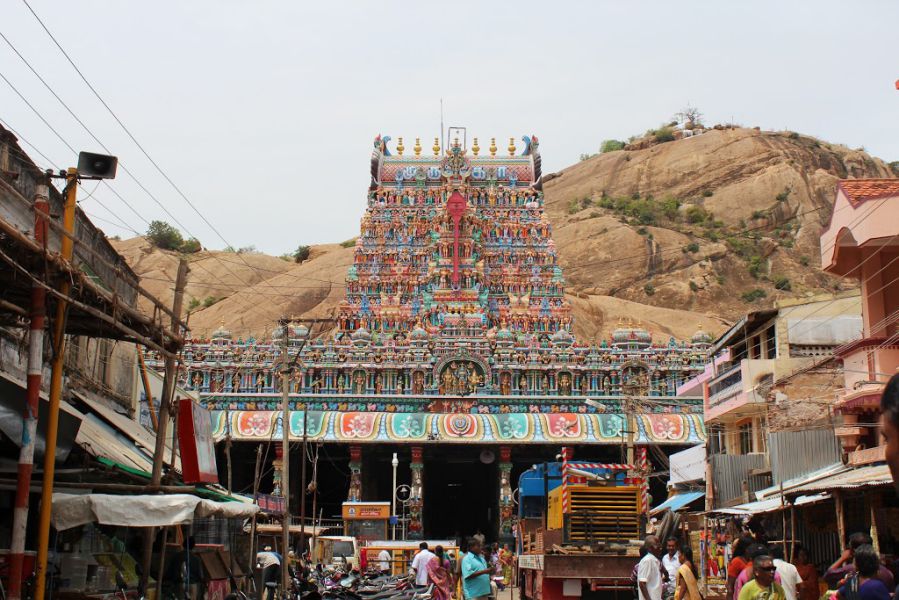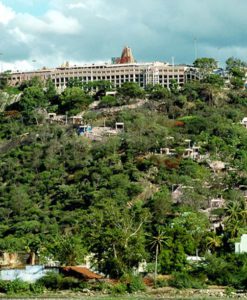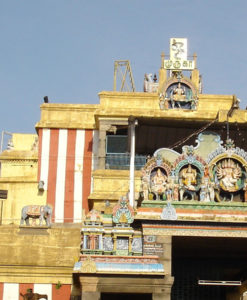No products in the cart.
Thirupparamkunram Murugan Temple
![]()
Thirupparamkunram Murugan Temple is located near Madurai in the state of Tamilnadu, India. It is one of the Arupadaiveedu (6 abodes or holy shrines of Lord Murugan). An interesting feature of this temple is that of deities of Lord Shiva and Lord Vishnu facing each other in the main shrine.
Tirupuramkundram is one of the six main pilgrimage sites for the devotion of the son of Shiva – Lord Murugan (also called Subramanya), the Tamil Hindu god of war and patron of Tamil Nadu. According to legend, the Lord married Deivyani, the daughter of Lord Indra at this place.The Thirupparamkunram Murugan Temple in Madurai dates back to the sixth century.The antiquity of Thirupparamkunram Murugan Temple can very well be gauged from the fact that it finds mention even in the Sangam Literature.
According to another tale King Harichandra worshipped Shiva from this hillock and gained eternal wisdom. Thus he built a temple here – temple was complete with Praharams (ambulatories), walls, Gopurams (gate towers) and steps.
The “real history” (who can differentiate myths and reality in Indian past?) of the temple may start with 8th century AD when Pandya rulers built a rock-cut temple. Later, during the reign of Nayaks of Madurai (1559 – 1736 AD) the temple was supplemented with beautiful gopurams and beautified.They also built extensive and beautiful front part (mugha mandapam) with 48 ornate pillars carved during the rule of Pandya and Nayaks.
It is possible that the worship history of this hill goes far into the past, may be even well before there appeared Hinduism. There are many legends associated with this mountain.Thus, the hill is considered to be the “Southern Himalaya” where the gods assemble. There is also legend that this is the place where Sun and Moon take a rest.
There are several architectural features of interest, especially the rock cut portions of this hill temple dating back to the Pandya period and the life sized sculptures in the mandapams of the Nayakar period. An Aasthaana Mandapam with several artistically carved pillars lead one to the towering 150 feet (46 m) high Rajagopuram at the entrance.
The Kambathadi Mandapam, Ardha Mandapam, and Mahamandapam are situated at different levels. The main shrine is an early rock cut temple which has cells that house the sanctums of Subramanya, Durga, Vinayakar, Shiva and Vishnu. All the statues are carved on the wall of the parankundram rock. The presiding deity of lord shiva is known as Parangirinathar and the female deity, his consort mother Parvati is known as Aavudai Nayaki. Panels depicting Shiva’s dance of bliss, the Shiva Tandava, are seen outside the sanctum. These magnificent works of art date back to the Pandya period.

A curious feature of this temple is that the Gods, Shiva and Vishnu face each other in the main shrine, and this is a rare thing in ancient Hindu temples. This is because Hinduism always held two distinct worshiping groups – Shaivites (worshippers of Lord Shiva) and Vaishnavites (worshippers of Lord Vishnu). Outside the temple there is a beautiful pond where, according to Temple tradition, the fishes are served with salt and rice flakes by the devotees. There is also a Vedic school adjacent to the banks of the temple pond.This temple was built by carving the hill.
In front of the Dwajasthambam or the Kodi Maram, one gets the magnificently carved Nandi, Mayil and the Mouse ( the vehicle of Lord Ganesha). This is a specialty of this Murugan shrine.Going inside, one can see the sannidhis of various Hindu Gods and Hindu Goddesses. Of special mention is the sannidhi of Saneeswaran without the other eight Grahas. Climbing a flight of six steps called the “Shadashara Padigal”, one reaches the Ardha Mandapam. One gets to see the rock carvings of Mahishasura Mardini ( Devi Mahatmyam describes the slaying of Mahishasura by Goddess Durga), Karpaga Vinayagar, Andarabaranar and Uggirar.
There is also a rock carved sannidhi for Lord Vishnu and Goddess Lakshmi. Shiva in the form Sivalingam and Sathiyagireeshwarar sannidhis located here cannot miss the attention of the Muruga Bakthas visiting this Murugan shrine.
The Moolavar deity is also sculptured from a rock. Abhishekams for the presiding deity is done to the Murugan’s Vel only.
There are five Theerthams, or divine water sources, in and around the temple, Saravana Poigai, Lakshmi Theertham, Saniyasi Kinaru (well), Kasi Sunai, and Sathiya Koopam.
Thirupparamkunram Murugan Temple By Bus
You can go by buses from Madurai bus stand.
Thirupparamkunram Murugan Temple By Railways
The nearest railway station is Madurai Railway Jn. From here you can go by bus or taxi.
Thirupparamkunram Murugan Temple By Flight
The nearest airport is Madurai Airport. From here you can go by bus or taxi.
Thirupparamkunram Murugan Temple
Thirupparamkunram Murugan Temple Timing
Morning: 5:30 A.M to 1:00 P.M
Evening: 4:00 P.M to 9:00 P.M
There are eight kalam(times) of poojas daily and they are as follows :







